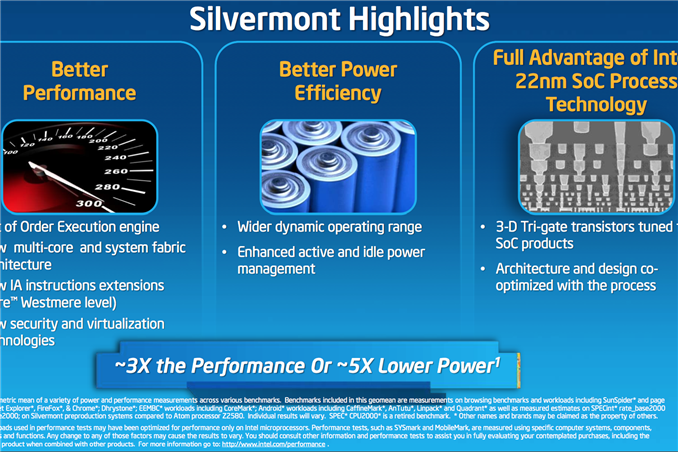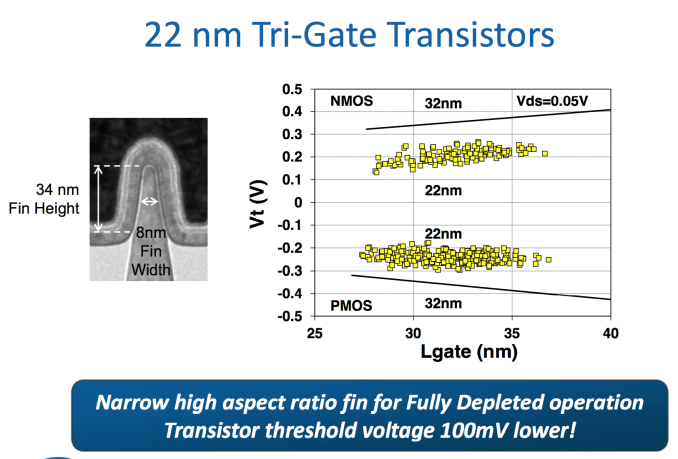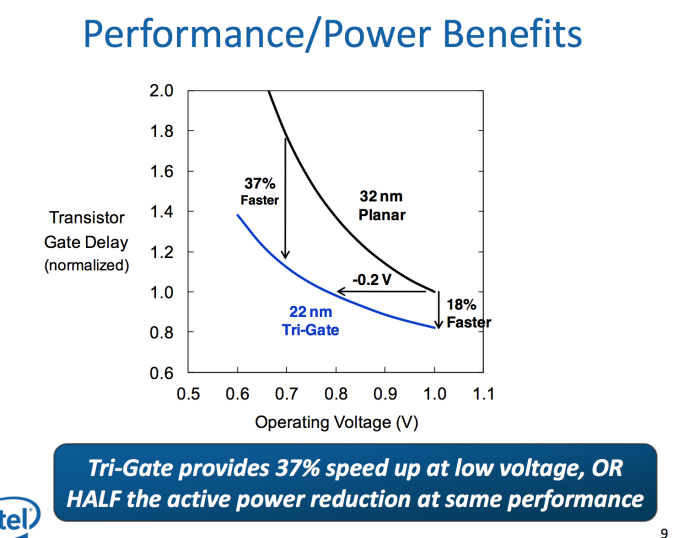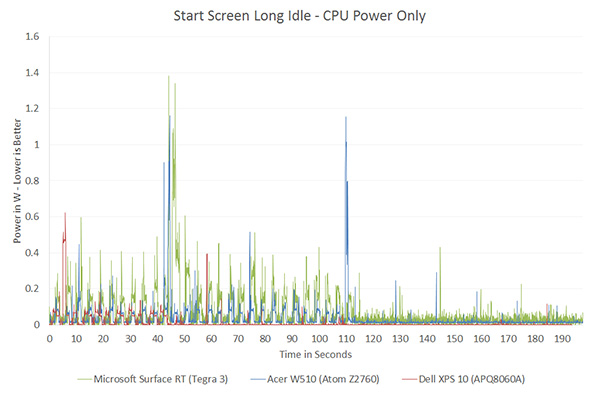Intel’s Silvermont Architecture Revealed: Getting Serious About Mobile
by Anand Lal Shimpi on May 6, 2013 1:00 PM EST- Posted in
- CPUs
- Intel
- Silvermont
- SoCs

The most frustrating part about covering Intel’s journey into mobile over the past five years is just how long it’s taken to get here. The CPU cores used in Medfield, Clover Trail and Clover Trail+ are very similar to what Intel had with the first Atom in 2008. Obviously we’re dealing with higher levels of integration and tweaks for further power consumption, but the architecture and much of the core remains unchanged. Just consider what that means. A single Bonnell core, designed in 2004, released in 2008, is already faster than ARM’s Cortex A9. Intel had this architecture for five years now and from the market’s perspective, did absolutely nothing with it. You could argue that the part wasn’t really ready until Intel had its 32nm process, so perhaps we’ve only wasted 3 years (Intel debuted its 32nm process in 2010). It’s beyond frustrating to think about just how competitive Intel would have been had it aggressively pursued this market.
Today Intel is in a different position. After acquisitions, new hires and some significant internal organizational changes, Intel seems to finally have the foundation to iterate and innovate in mobile. Although Bonnell (the first Atom core) was the beginning of Intel’s journey into mobile, it’s Silvermont - Intel’s first new Atom microarchitecture since 2008 - that finally puts Intel on the right course.
Although Silvermont can find its way into everything from cars to servers, the architecture is primarily optimized for use in smartphones and then in tablets, in that order. This is a significant departure from the previous Bonnell core that was first designed to serve the now defunct Mobile Internet Devices category that Intel put so much faith in back in the early to mid 2000s. As Intel’s first Atom architecture designed for mobile, expectations are high for Silvermont. While we’ll have to wait until the end of the year to see Silvermont in tablets (and early next year for phones), the good news for Intel is that Silvermont seems competitive right out of the gate. The even better news is that Silvermont will only be with us for a year before it gets its first update: Airmont.
 Intel made this announcement last year, but Silvermont is the beginning of Intel’s tick-tock cadence for Atom. Intel plans on revving Atom yearly for at least the next three years. Silvermont introduces a new architecture, while Airmont will take that architecture and bring it down to 14nm in 2014/2015. One year later, we’ll see another brand new architecture take the stage also on 14nm. This is a shift that Intel needed to implement years ago, but it’s still not too late.
Intel made this announcement last year, but Silvermont is the beginning of Intel’s tick-tock cadence for Atom. Intel plans on revving Atom yearly for at least the next three years. Silvermont introduces a new architecture, while Airmont will take that architecture and bring it down to 14nm in 2014/2015. One year later, we’ll see another brand new architecture take the stage also on 14nm. This is a shift that Intel needed to implement years ago, but it’s still not too late.
Before we get into an architectural analysis of Silvermont, it’s important to get some codenames in order. Bonnell was the name of the original 45nm Atom core, it was later shrunk to 32nm and called Saltwell when it arrived in smartphones and tablets last year. Silvermont is the name of the CPU core alone, but when it shows up in tablets later this year it will do so as a part of the Baytrail SoC and a part of the Merrifield SoC next year in smartphones.
22nm
To really understand the Silvermont story, you need to first understand Intel’s 22nm SoC process. Two years ago Intel announced its 22nm tri-gate 3D transistors, which would eventually ship a year later in Intel’s Ivy Bridge processors. That process wasn’t suited for ultra mobile. It was optimized for the sort of high performance silicon that was deployed on it, but not the ultra compact, very affordable, low power silicon necessary in smartphones and tablets. A derivative of that process would be needed for mobile. Intel now makes two versions of all of its processes, one optimized for its high performance CPUs and one for low power SoCs. P1270 was the 22nm CPU process, and P1271 is the low power SoC version. Silvermont uses P1271. The high level characteristics are the same however. Intel’s 22nm process moves to tri-gate non-planar transistors that can significantly increase transistor performance and/or decrease power.
This part is huge. The move to 22nm 3D transistors lets Intel drop threshold voltage by approximately 100mV at the same leakage level. Remember that power scales with the square of voltage, so a 100mV savings depending on what voltage you’re talking about can be very huge. Intel’s numbers put the power savings at anywhere from 25 - 35% at threshold voltage. The gains don’t stop there either. At 1V, Intel’s 22nm process gives it an 18% improvement in transistor performance or at the same performance Intel can run the transistors at 0.8V - a 20% power savings. The benefits are even more pronounced at lower voltages: 37% faster performance at 0.7V or less than half the active power at the same performance.
The end result here is Intel can scale frequency and/or add more active logic without drawing any more power than it did at 32nm. This helps at the top end with performance, but the vast majority of the time mobile devices are operating at very lower performance and power levels. Where performance doesn’t matter as much, Intel’s 22nm process gives it an insane advantage.
If we look back at our first x86 vs. ARM performance data we get a good indication of where Intel’s 32nm process had issues and where we should see tangible improvements with the move to 22nm:
Qualcomm’s 28nm Krait 200 was actually able to get down to lower power levels than Intel could at 32nm. Without having specific data I can’t say for certain, but it’s extremely likely that with Silvermont Intel will be able to drive down to far lower power levels than anything we’ve ever measured.
Understanding what Intel’s 22nm process gives it is really key to understanding Silvermont.













174 Comments
View All Comments
Hector2 - Friday, May 17, 2013 - link
There are only 3 companies right now left in the world who have the muscle and volume to afford high tech fabs -- Intel, Samsung & TSMC. And Intel has about a 2 year lead. That means not just higher performance and lower power than before, but lower cost. Making the chips smaller multiplies the number of chips on a single, fixed-cost wafer and lowers costs. If the chip area is 1/2, the costs to make it are about 1/2 as well. 22nm tech gives Intel faster chips with less power than their competition. 14nm hits it out of the park.BMNify - Wednesday, June 5, 2013 - link
You're absolutely wrong about "lower cost". x86 requires more die area. The process is more volatile (more failed wafers).If we combine the 2 above factors with better performance, lower power consumption and toss in a lack of experience we get GT3e. A technological marvel that few (OEMs) want.
BMNify - Wednesday, June 5, 2013 - link
Spot on Krysto - It's Intel's process advantage that is shining through. Soon they'll hit the point of diminishing returns and/or the rest of the market will catch up/get close enough. When I see AMD at 32nm (Richland) having lower power draw at idle than Intel at 22nm (Ivy Bridge) I wonder how special their "secret sauce" actually is.How long can Intel loss-lead? Probably as long as Xeon continues to make up for it but ARM is getting into the server market now too (looking forward to AMD and Calexda ARM SoCs for the server market). Should be interesting in 3-5 years
TheinsanegamerN - Monday, August 26, 2013 - link
only issue, though, is when you put that richland chip under load. all of a sudden, intel is using much less power.t.s. - Monday, May 6, 2013 - link
"The mobile market is far more competitive than the PC industry was back when Conroe hit. There isn’t just one AMD, but many competitors in the SoC space that are already very lean fast moving. There’s also the fact that Intel doesn’t have tremendous marketshare in ultra mobile."Well, with their 'strategy' back then when facing AMD (http://news.bbc.co.uk/2/hi/8047546.stm), they surely'll win. :p
nunomoreira10 - Monday, May 6, 2013 - link
It´s kinda suspicious that there are many comparisons against arm but none against Amd jaguar or even bobcat.jaguar will probably be a much better tablet cpu and gpu, while intel competes on the phone market.
Khato - Monday, May 6, 2013 - link
Which AMD Jaguar/Bobcat SKU runs at 1.5 watts? They aren't included in the comparison because they're a markedly higher power level.nunomoreira10 - Monday, May 6, 2013 - link
they will both be used on fan-less tablet designs...extide - Tuesday, May 7, 2013 - link
Totally different markets. Jaguar/Bobcat will likely line up next to low end Core/Haswell, not an Atom/SilvermontPenti - Tuesday, May 7, 2013 - link
Both will sadly be way to underpowered when it comes to the GPU, and that matters greatly on general OS's and applications like running a desktop OS X or Windows (or GNU/Linux) machine. You won't really be able to game on them at all as it's not smartphone games people want to run. GPGPU won't really be fast enough for anything and we talk about ~100-200 GFLOPs GPU-power on the AMD side for what is essentially a full blown computer.Intel is clearly targeting the phone market. Something AMD/ATI divested from years back with their mobile GPU tech going to Qualcomm (Adreno, which isn't Radeon-based) and Broadcom. ATIs/AMDs mobile GPU-tech was before that previously licensed to or used together with the likes of Intel (PXA/XScale – not integrated though), Samsung and Freescale among others. Their technology already is the mainstay of the mobile business and was departed from the company but in effect their technology know how was successful in the market without their leadership so why would they compete with that, of course they wouldn't.
AMD simply has not and will not likely any time soon invest in an alternate route to dominate their own part of the smartphone/ARM-tablet market while Intel has with integrated designs replacing the custom ARMv5TE design. AMD going after ARM-business is different since they will license the core and their manufacturer GloFo already does manufactures and even offers hard macros for ARM-designs that they sell a bunch of to other customers already. It's also going after other embedded fields and the emerging ARM-server/appliance space all without designing custom cores.
While PXA (Intel) was quite successful in the market, moving to x86 and doing away with stuff like ARM-based network processors, raid-processors allows Intel to focus on delivering great support for modern ISA across all sorts of devices, while it didn't make it into phones (until lately) like PXA which continued to power Blackberrys under Marvell, was the main Windows Mobile platform for years after Intels departure and so on it was able to become a multimediaplatform, and a widely adopted chip for embedded use, driving NAS-devices and the like. Thanks to the Intel purchase of Infineons Wireless portfolio including many popular 3G radios/modems and them forming a new wireless division their actual business and sales in the mobile market is also much higher than when they still had their custom PXA/XScale lineup. Plus they couldn't have competed with their XScale lineup without designing new ARM-ISA compatible cores/designs to be able to match Cortex A8, A9, A7, A15, Krait 600 etc. Plus puts them in a much better place to be a wireless/terminal supplier when they can support customers who want advanced wireless modems/baseband, Application processors, bt, wifi etc. While Nvidia will have Tegra 4i with integrated modem AMD couldn't offer anything similar as they have no team capable of producing radio baseband. Having modern compilers and x86-ISA sure makes it convenient now for Intel, as well as integrating their own GPU, just licensing ARM Ltd designs wouldn't have put them in a better position to continue their presence in the mobile field. They have basically developed and scaled their desktop GNU/Linux drivers in the Linux Kernel, added mobile features and so on years before they put the hardware and can leverage that software in mobile platforms (Android) but it makes sense and they don't have to rely on IP cores and third party drivers for graphics with the coming Bay Trail. They couldn't have shared that much tech if they were anything else then x86. Of course AMD won't be in the same place and scaling down a GPU designed for thousands of stream processors and Windows/OS X drivers to put it into phones is not the same. It would be awful if it is just scaled down to fit the power usage, even if Nvidia has kinda custom mobile gpu it's still worse then the competitors which has no presence in desktop computing. Drivers for QNX, Android/Linux, iOS etc is not the same as with Windows either. It takes a long time to start over when they did away with an okay solution (z460), and they haven't but other have and thats fine, there is more competition here then elsewhere. x86 is no stopper for Intel.